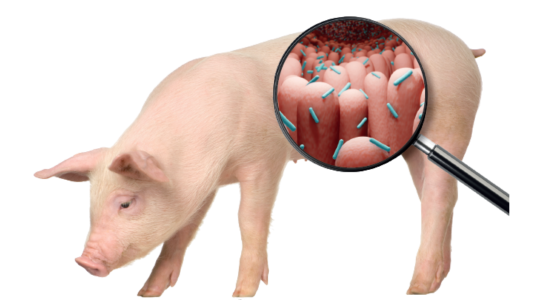Dietary lipids play an important role in modulating the pig immune system. The gastrointestinal tract (GIT) is not only an important organ for digestion, absorption, and metabolism of dietary nutrients, but it is also the body’s largest immune organ and involves more than 70% of the body’s immune cells (Blikslager et al., 2007).
Pigs face numerous pathogenic and non-pathogenic challenges after weaning, resulting in activation of the gastrointestinal immune system.
While a healthy GIT is considered to be in a constant state of “controlled” inflammation, intestinal infections caused by pathogenic bacteria such as E. coli and Salmonella can dramatically amplify inflammatory responses.
During activation of the GIT immune system, several pro-inflammatory cytokines are produced. An overproduction of these cytokines results in intestinal injury and dysfunction.
Fatty Acids (FAs) play a fundamental role as immune modulators. Contributing as:
- Main sources of energy
- Important components in cell membranes
- Metabolic substrates in many biochemical pathways and cell signaling molecules
Focusing on the prevention of enteric diseases in pigs and broilers, Lauridsen (2019) described the influence of early nutrition with n-6 and n-3 dietary FAs on the synthesis of long-chain PUFA and eicosanoids. Including mechanisms for inflammatory responses and oxidative stress in these animals.
Conjugated linoleic acid (CLA) has been studied for its impact on intestinal immunity in growing and finishing pigs (Lauridsen et al., 2005; Tous et al. , 2012).
- Therefore, in this study (Patterson et al., 2008), as well as in the study by Lauridsen and Jensen (2007), a carryover effect was obtained. It was seen that the FA dietary treatment of sows influenced the lactating piglet through the fatty acid composition of the sow’s milk. The effect persisted in the form of enhanced immunity in the piglet after weaning.
Function of the intestinal epithelium
Several conditions damage the intestinal epithelium and consequently cause poor absorption of nutrients. In general, E. coli infection can:
- Decrease the height of the villi (villi atrophy)
- Increase crypt depth (crypt elongation)
- Exert detrimental effects on the relationship between the height of the villi and the depth of the crypts, the area of the villi and the volume of the villi, and can even destroy the villi.
In addition to a high cell turnover in the intestinal epithelium, oxidative stress and lipid oxidation products can also alter the barrier function of the epithelial monolayer.
- Fortunately, and even in case of overt inflammation, intestinal epithelium replacement is a process that occurs rapidly with cells proliferating in the crypts, maturing along the villi axis, and exfoliating from the tip of the villi. With a turnover rate of approximately 3 to 5 days (Potten et al. al., 1997).
Intestinal epithelial turnover is an important innate defense mechanism, which is greatly affected by microbial colonization (Willing et al. , 2013). Rates of cell loss and proliferation are largely determined by the activation of immune mechanisms associated with commensal bacteria.
- Thus, in addition to affecting digestion and absorption functions, inflammation can exert a detrimental effect on intestinal barrier function. For example by buffering the mechanisms that prevent the penetration of luminal bacteria and dietary allergens into the mucosa (Blikslager et al. , 2007).
FAs, mainly medium and long chain FAs (MCFA and LCFA, respectively), influence intestinal morphology and epithelial barrier functions through different mechanisms (Liu, 2015). Inflammation often results in the redirection of the host’s energy towards other functions other than digestion.
This impact may be more significant in piglets after weaning, as enterocytes directly use MCFAs for energy production and thus maintain intestinal tissue integrity (Guillot et al., 1993).
Mixtures of fat sources, especially those that include a high content of free fatty acids, may increase the risk of oxidative stress and inflammation and thus impair intestinal integrity (Zhu et al. , 2012).
The dietary challenge of piglets during weaning with peroxidized oil did not affect the histomorphology of the small intestine (Degroote et al., 2019);
- However, the impact of dietary antioxidants in that study cannot be ignored, as malondialdehyde levels in the plasma and liver of piglets were also unaffected.
Feeding thermally peroxidized soybean oil to growing pigs had little impact on intestinal permeability measured as: urinary lactulose:mannitol ratio (Overholt et al., 2018).
As recently reviewed, the inclusion of vitamins E and A and trace elements such as Zn, Mn and Cu provides significant protection against membrane hydroperoxide abuse through their antioxidant mechanisms (Dalgaard et al., 2018; Lauridsen, 2019).
| Hence, when modifying dietary fatty acid composition, the risk of oxidative processes within cell membranes must always be considered. The integration of α-tocopherol between plasma membrane FAs (Lauridsen and Jensen, 2012) is of great structural importance for intestinal barrier function. |
You may also like to read: “Influence of lipids on the intestinal health of piglets.”
